Abstract
The methylxanthines caffeine, theophylline, and isobutylmethylxanthine greatly increased spore yields of Clostridium perfringens strains FD-1, PS52, and PS49 when grown on Duncan-Strong medium or on a new casein-digest medium. Four other strains (KA3, and National Collection of Type Cultures strains 8798, 8238, and 10240) failed to show any significant increase when tested under similar conditions. The degree of sporulation increase was influenced by the carbohydrate energy source in some strains but not in others. Strain PS52 showed a large increase in spore yield when dextrin was the energy source but only a slight increase when raffinose served as the energy source. Strain FD-1 showed similar increases in spore yield with either dextrin or raffinose.
Full text
PDF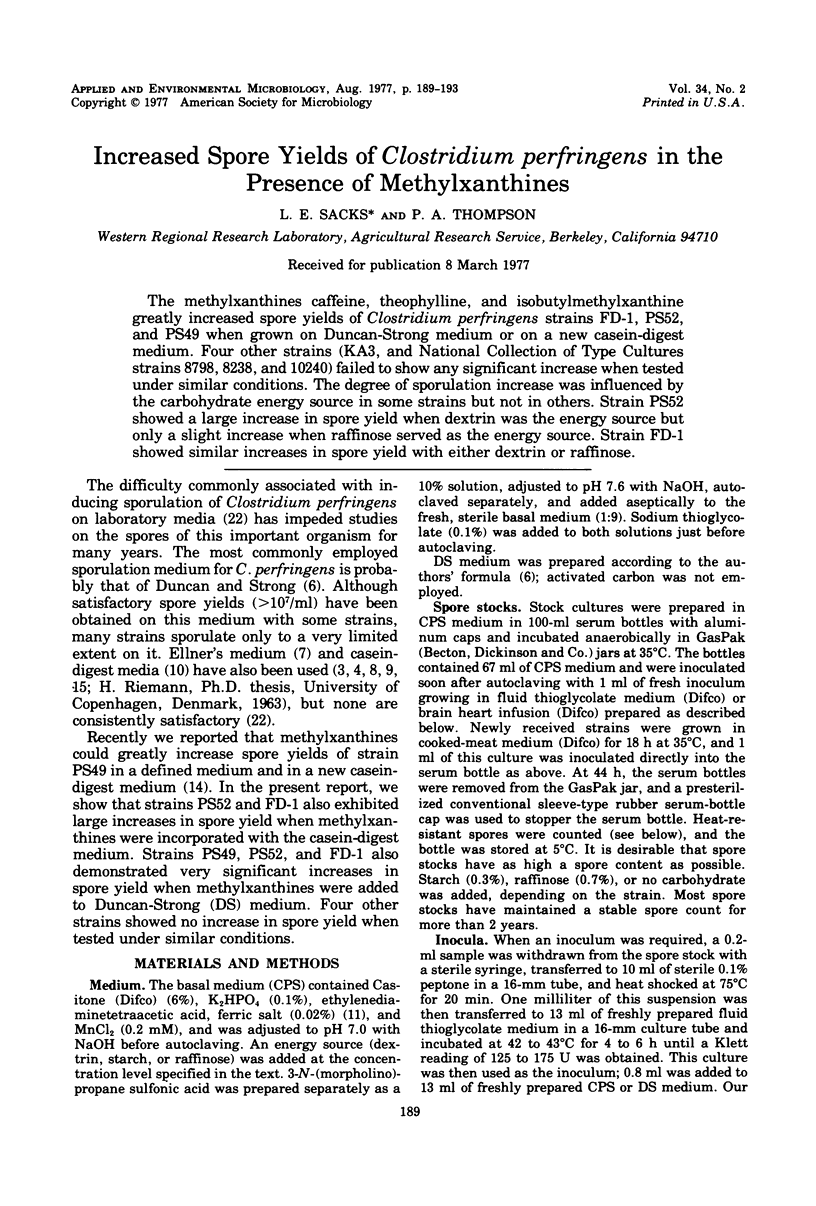
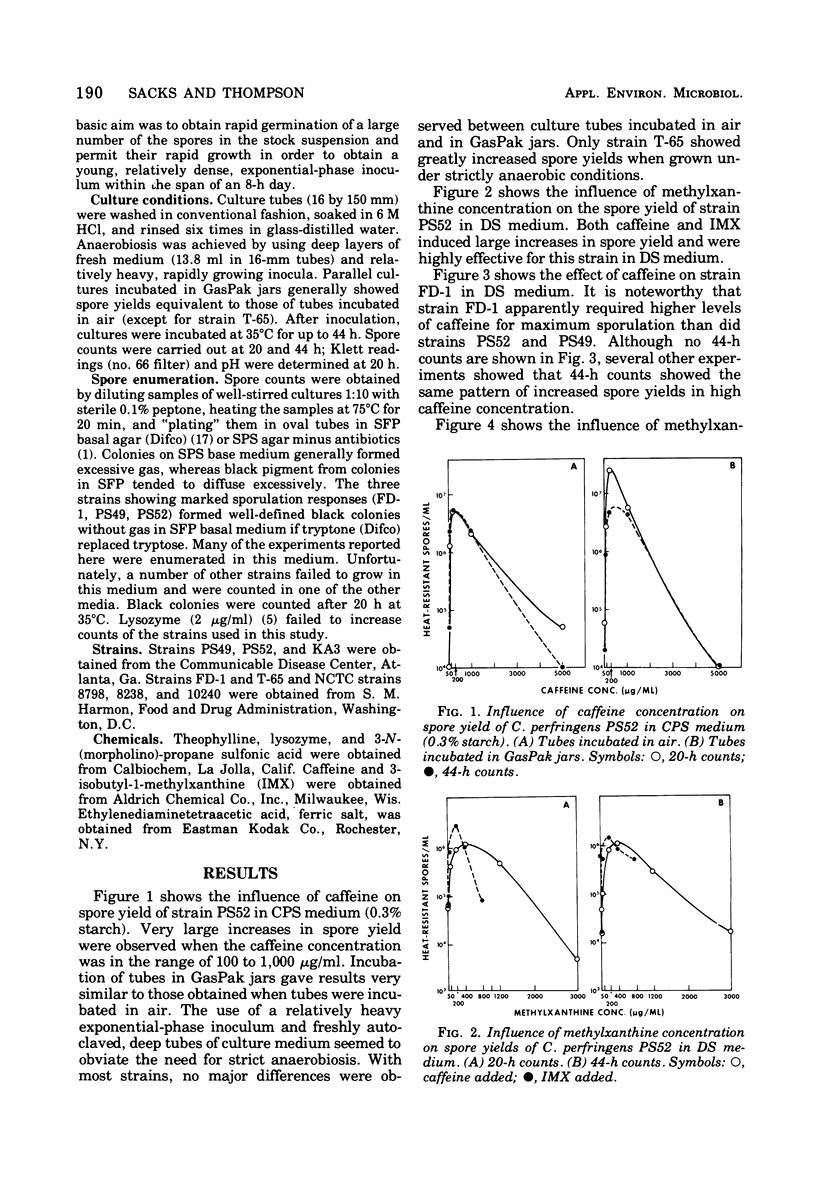
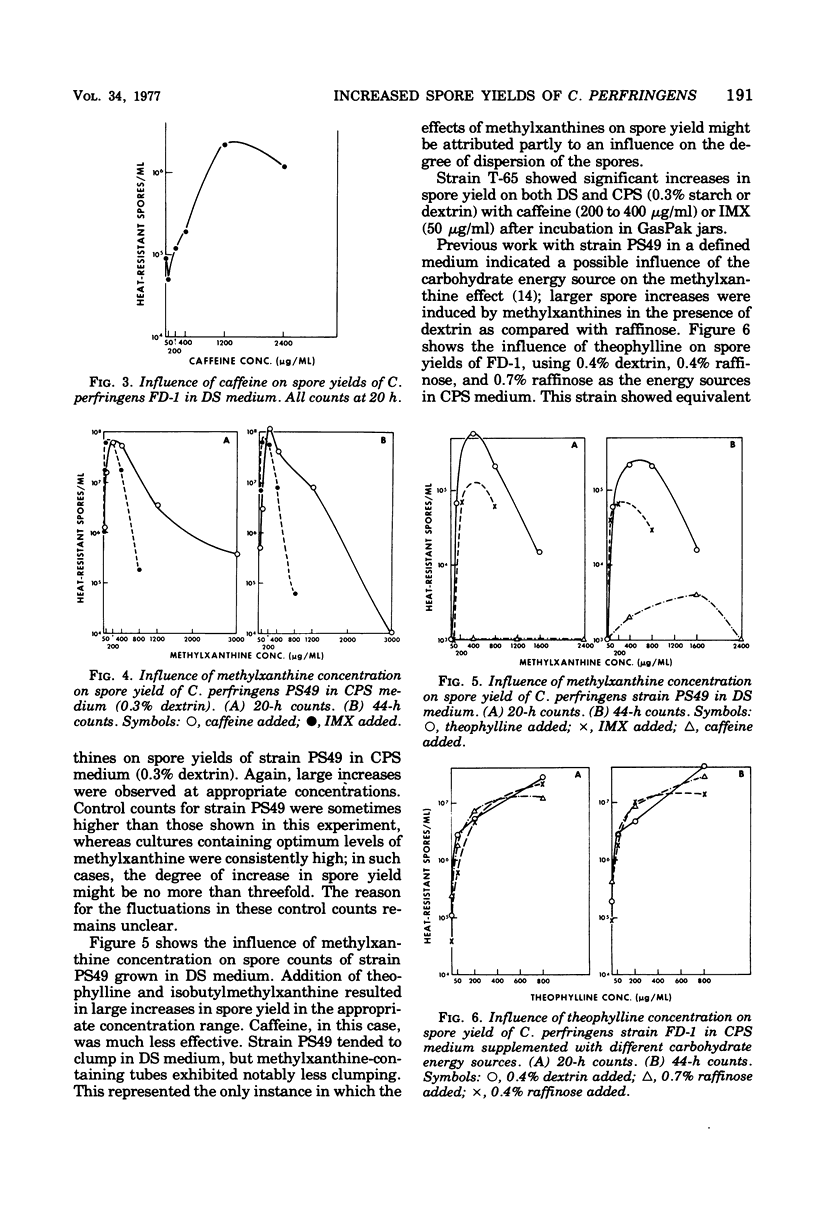
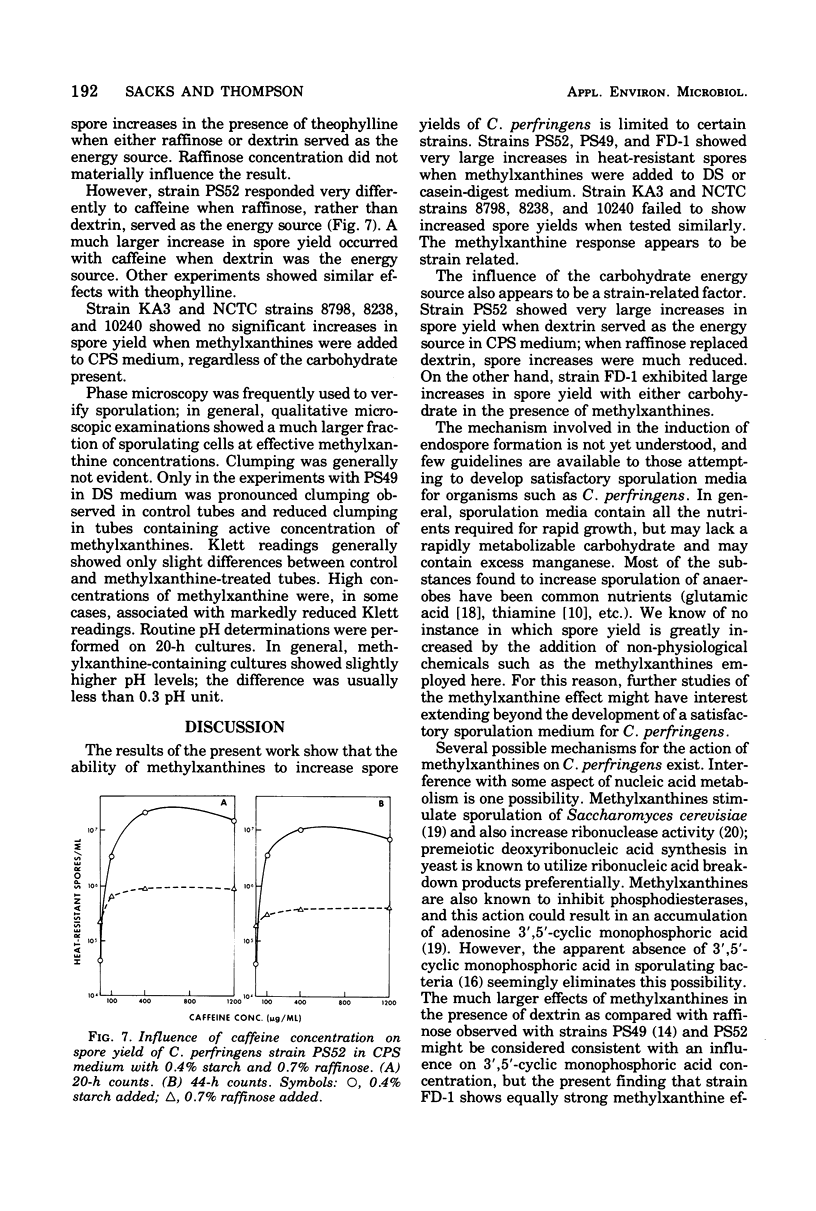
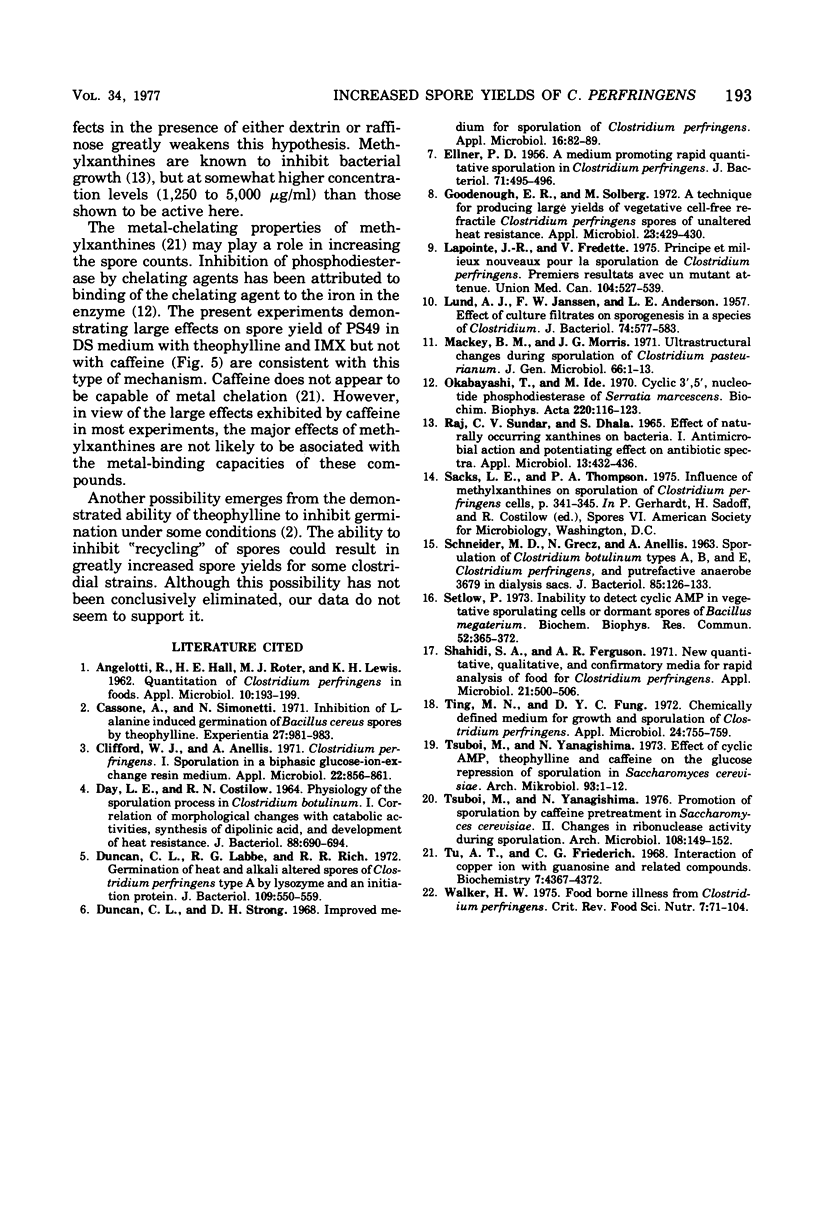
Selected References
These references are in PubMed. This may not be the complete list of references from this article.
- ANGELOTTI R., HALL H. E., FOTER M. J., LEWIS K. H. Quantitation of Clostridium perfringens in foods. Appl Microbiol. 1962 May;10:193–199. doi: 10.1128/am.10.3.193-199.1962. [DOI] [PMC free article] [PubMed] [Google Scholar]
- Cassone A., Simonetti N. Inhibition of L-alanine-induced germination of Bacillus cereus spores by theophylline. Experientia. 1971 Aug;27(8):981–983. doi: 10.1007/BF02135788. [DOI] [PubMed] [Google Scholar]
- Clifford W. J., Anellis A. Clostridium perfringens. I. Sporulation in a biphasic glucose-ion-exchange resin medium. Appl Microbiol. 1971 Nov;22(5):856–861. doi: 10.1128/am.22.5.856-861.1971. [DOI] [PMC free article] [PubMed] [Google Scholar]
- DAY L. E., COSTILOW R. N. PHYSIOLOGY OF THE SPORULATION PROCESS IN CLOSTRIDIUM BOTULINUM. I. CORRELATION OF MORPHOLOGICAL CHANGES WITH CATABOLIC ACTIVITIES, SYNTHESIS OF DIPICOLINIC ACID, AND DEVELOPMENT OF HEAT RESISTANCE. J Bacteriol. 1964 Sep;88:690–694. doi: 10.1128/jb.88.3.690-694.1964. [DOI] [PMC free article] [PubMed] [Google Scholar]
- Duncan C. L., Labbe R. G., Reich R. R. Germination of heat- and alkali-altered spores of Clostridium perfringens type A by lysozyme and an initiation protein. J Bacteriol. 1972 Feb;109(2):550–559. doi: 10.1128/jb.109.2.550-559.1972. [DOI] [PMC free article] [PubMed] [Google Scholar]
- Duncan C. L., Strong D. H. Improved medium for sporulation of Clostridium perfringens. Appl Microbiol. 1968 Jan;16(1):82–89. doi: 10.1128/am.16.1.82-89.1968. [DOI] [PMC free article] [PubMed] [Google Scholar]
- ELLNER P. D. A medium promoting rapid quantitative sporulation in Clostridium perfringens. J Bacteriol. 1956 Apr;71(4):495–496. doi: 10.1128/jb.71.4.495-496.1956. [DOI] [PMC free article] [PubMed] [Google Scholar]
- Goodenough E. R., Solberg M. A technique for producing large yields of vegetative cell-free refractile Clostridium perfringens spores of unaltered heat resistance. Appl Microbiol. 1972 Feb;23(2):429–430. doi: 10.1128/am.23.2.429-430.1972. [DOI] [PMC free article] [PubMed] [Google Scholar]
- LUND A. J., JANSSEN F. W., ANDERSON L. E. Effect of culture filtrates on sporogenesis in a species of Clostridium. J Bacteriol. 1957 Nov;74(5):577–583. doi: 10.1128/jb.74.5.577-583.1957. [DOI] [PMC free article] [PubMed] [Google Scholar]
- Lapointe J. R., Fredette V. Principe et milieux nouveaux pour la sporulation de clostridium perfringens. Premiers résultats avec un mutant atténué. Union Med Can. 1975 Apr;104(4):527–538. [PubMed] [Google Scholar]
- Okabayashi T., Ide M. Cyclic 3',5'-nucleotide phosphodiesterase of Serratia marcescens. Biochim Biophys Acta. 1970 Oct 14;220(1):116–123. doi: 10.1016/0005-2744(70)90235-4. [DOI] [PubMed] [Google Scholar]
- RAJ C. V., DHALA S. EFFECT OF NATURALLY OCCURRING XANTHINES ON BACTERIA. I. ANTIMICROBIAL ACTION AND POTENTIATING EFFECT ON ANTIBIOTIC SPECTRA. Appl Microbiol. 1965 May;13:432–436. doi: 10.1128/am.13.3.432-436.1965. [DOI] [PMC free article] [PubMed] [Google Scholar]
- SCHNEIDER M. D., GRECZ N., ANELLIS A. Sporulation of Clostridium botulinum types A, B, and E, Clostridium perfringens, and putrefactive anaerobe 3679 in dialysis sacs. J Bacteriol. 1963 Jan;85:126–133. doi: 10.1128/jb.85.1.126-133.1963. [DOI] [PMC free article] [PubMed] [Google Scholar]
- Setlow P. Inability of detect cyclic AMP in vegetative or sporulating cells or dormant spores of Bacillus megaterium. Biochem Biophys Res Commun. 1973 May 15;52(2):365–372. doi: 10.1016/0006-291x(73)90720-1. [DOI] [PubMed] [Google Scholar]
- Shahidi S. A., Ferguson A. R. New quantitative, qualitative, and confirmatory media for rapid analysis of food for Clostridium perfringens. Appl Microbiol. 1971 Mar;21(3):500–506. doi: 10.1128/am.21.3.500-506.1971. [DOI] [PMC free article] [PubMed] [Google Scholar]
- Ting M. N., Fung D. Y. Chemically defined medium for growth and sporulation of Clostridium perfringens. Appl Microbiol. 1972 Nov;24(5):755–759. doi: 10.1128/am.24.5.755-759.1972. [DOI] [PMC free article] [PubMed] [Google Scholar]
- Tsuboi M., Yanagishima N. Effect of cyclic AMP, theophylline and caffeine on the glucose repression of sporulation in Saccharomyces cerevisiae. Arch Mikrobiol. 1973 Oct 4;93(1):1–12. doi: 10.1007/BF00666076. [DOI] [PubMed] [Google Scholar]
- Tsuboi M., Yanagishima N. Promotion of sporulation by caffeine pretreatment in Saccharomyces cerevisiae. II. Changes in ribonuclease activity during sporulation. Arch Microbiol. 1976 Jun;108(2):149–152. doi: 10.1007/BF00428944. [DOI] [PubMed] [Google Scholar]
- Tu A. T., Friederich C. G. Interaction of copper ion with guanosine and related compounds. Biochemistry. 1968 Dec;7(12):4367–4372. doi: 10.1021/bi00852a032. [DOI] [PubMed] [Google Scholar]


